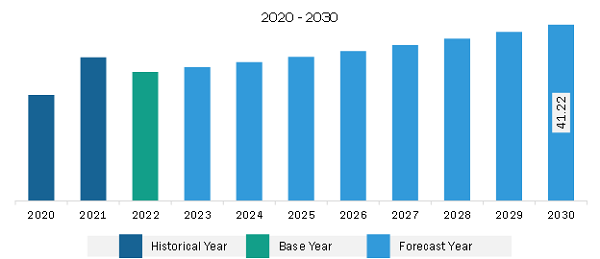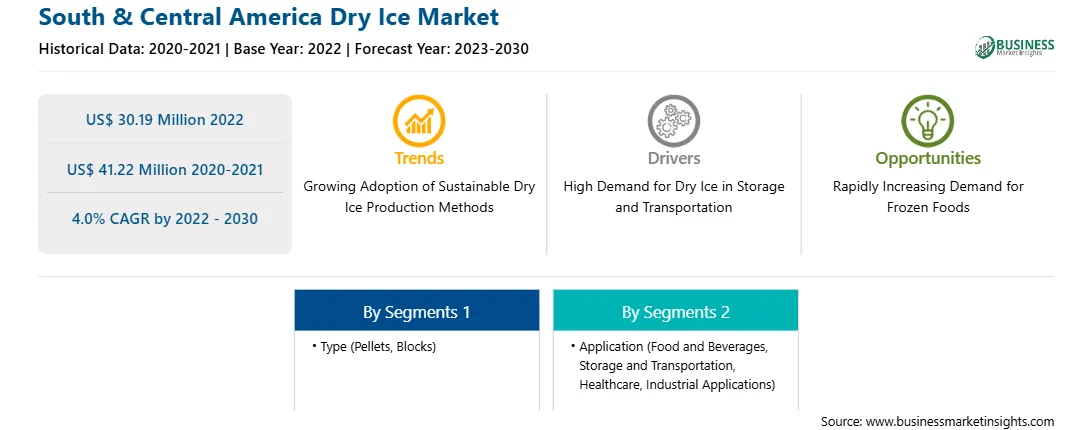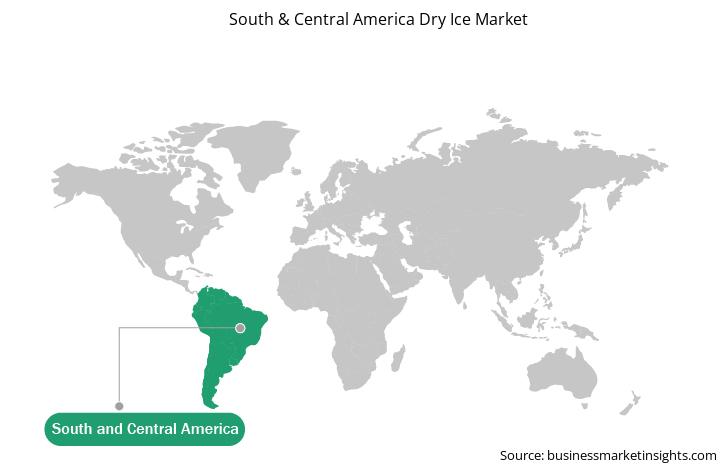The South & Central America dry ice market was valued at US$ 30.19 million in 2022 and is expected to reach US$ 41.22 million by 2030; it is estimated to register a CAGR of 4.0% from 2022 to 2030.
An increase in demand for frozen foods and a rise in the usage of dry ice as refrigerant in food and shipping industries are key factors anticipated to provide growth opportunities to the South & Central America dry ice market. Dry ice is carbon dioxide in its solid form. This dense, snowlike substance sublimes at −78.5 °C (−109.3 °F), used as a refrigerant, especially during the shipping of perishable products such as meats or ice cream. As the dry ice sublimes, it leaves no residue to contaminate or compromise the quality of food.
Over the past few years, the lifestyle of people globally evolved dramatically. Due to hectic work schedules, people are looking for products that save time and effort. Consumers prefer ready-to-eat, microwavable, and ready-to-prepare food products as they are highly recommended for on-the-go consumption and require minimal preparation time. Moreover, the increasing working women population, high per capita income, and a rising middle-class population are key factors driving the growth of convenience food consumption globally. Due to the increasing number of nuclear families, the demand for prepared-to-eat, portion-controlled food increased. The market for frozen food products is also growing as they have extended shelf-life, are suitable for single-person consumption, and can be prepared in less time. Dry ice plays a crucial role in preserving the quality and safety of these frozen food products throughout their storage, transportation, and distribution.
The high demand for frozen meat & poultry, and seafood owing to the increasing awareness among consumers regarding the health benefits offered by meat and seafood favors the market. These products are low-fat and high-protein foods that can help to build muscle, boost brainpower, improve eyesight, support heart health, relieve joint discomfort, and improve skin and hair. Consumers are shifting toward a healthy lifestyle, which has led to a high demand for healthy food with nutritional value. Unlike traditional water-based ice, dry ice sublimates, transitioning directly from solid to gas, eliminating the risk of moisture accumulation and freezer burn. This makes it an ideal cooling agent for frozen food, ensuring that products remain frozen and maintain their texture, taste, and nutritional value. Hence, the surge in demand for frozen food products is ultimately bolstering the dry ice market.
According to the Brazilian Foreign Trade Secretariat statistics, from 2021 to 2022, Brazil has seen significant growth in its meat export. This fast rise is attributable to rising consumer demand due to changing lifestyles and modern technology. With rising consumer demand for frozen food products and a highly competitive market, most food processors, distributors, and retailers are transitioning from manually operated warehouse facilities to automatic deep-freeze warehouses with the widespread use of dry ice. In addition, according to the Organization for Economic Co-operation and Development-Food and Agriculture Organization agricultural outlook, agricultural and fish production in South & Central America is projected to grow by 14% by 2032. Additionally, according to the Wisconsin Economic Development Corporation, in 2020, Chile exported agricultural products and agricultural, construction, healthcare, safety and security, mining, and telecommunication machinery and equipment worth US$ 229 million. Dry ice is used to extend and ensure the shelf life of fresh agricultural products, seafood, frozen food, and pharmaceuticals will grow substantially. These factors are expected to drive the South & Central American dry ice market.

Strategic insights for the South & Central America Dry Ice provides data-driven analysis of the industry landscape, including current trends, key players, and regional nuances. These insights offer actionable recommendations, enabling readers to differentiate themselves from competitors by identifying untapped segments or developing unique value propositions. Leveraging data analytics, these insights help industry players anticipate the market shifts, whether investors, manufacturers, or other stakeholders. A future-oriented perspective is essential, helping stakeholders anticipate market shifts and position themselves for long-term success in this dynamic region. Ultimately, effective strategic insights empower readers to make informed decisions that drive profitability and achieve their business objectives within the market.

| Report Attribute | Details |
|---|---|
| Market size in 2022 | US$ 30.19 Million |
| Market Size by 2030 | US$ 41.22 Million |
| Global CAGR (2022 - 2030) | 4.0% |
| Historical Data | 2020-2021 |
| Forecast period | 2023-2030 |
| Segments Covered |
By Type
|
| Regions and Countries Covered | South and Central America
|
| Market leaders and key company profiles |
The geographic scope of the South & Central America Dry Ice refers to the specific areas in which a business operates and competes. Understanding local distinctions, such as diverse consumer preferences (e.g., demand for specific plug types or battery backup durations), varying economic conditions, and regulatory environments, is crucial for tailoring strategies to specific markets. Businesses can expand their reach by identifying underserved areas or adapting their offerings to meet local demands. A clear market focus allows for more effective resource allocation, targeted marketing campaigns, and better positioning against local competitors, ultimately driving growth in those targeted areas.

The South & Central America dry ice market is categorized into type, application, and country.
Based on type, the South & Central America dry ice market is segmented into pellets, blocks, and others. The blocks segment held the largest market share in 2022.
In terms of application, the South & Central America dry ice market is segmented into food and beverages, storage and transportation, healthcare, industrial applications, and others. The storage and transportation held the largest market share in 2022.
By country, the South & Central America dry ice market is segmented into Brazil, Argentina, and the Rest of South & Central America. Brazil dominated the South & Central America dry ice market share in 2022.
Continental Carbonic Products Inc, L’Air Liquide SA, Linde Plc, and SOL SpA are some of the leading companies operating in the South & Central America dry ice market.
The South & Central America Dry Ice Market is valued at US$ 30.19 Million in 2022, it is projected to reach US$ 41.22 Million by 2030.
As per our report South & Central America Dry Ice Market, the market size is valued at US$ 30.19 Million in 2022, projecting it to reach US$ 41.22 Million by 2030. This translates to a CAGR of approximately 4.0% during the forecast period.
The South & Central America Dry Ice Market report typically cover these key segments-
The historic period, base year, and forecast period can vary slightly depending on the specific market research report. However, for the South & Central America Dry Ice Market report:
The South & Central America Dry Ice Market is populated by several key players, each contributing to its growth and innovation. Some of the major players include:
The South & Central America Dry Ice Market report is valuable for diverse stakeholders, including:
Essentially, anyone involved in or considering involvement in the South & Central America Dry Ice Market value chain can benefit from the information contained in a comprehensive market report.